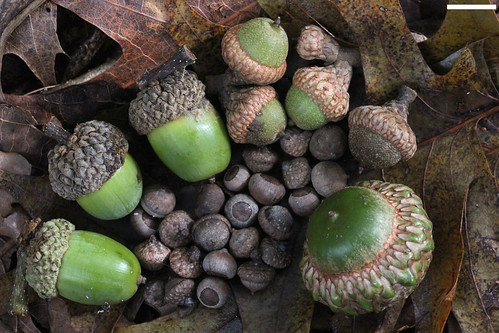Acorns from small to large of the Willow Oak, Quercus phellos (very small, at center), the Southern Red Oak, Quercus falcata, the White Oak, Quercus alba, and the Scarlet Oak, Quercus coccinea, from southern Greenville County, SC, USA, scale bar at upper right is 1.00 cm Photo by David Hill, published under Creative Commons https://www.flickr.com/photos/dehill/7891890620/
My aging dog sits by my side in the evening and together we listen to the plunk of acorns on the roof. I can tell he is getting older; years ago every acorn was accompanied by shock and vigorous barking protestations. But while he is barking less, this year has involved a lot of acorns sounds. Acorns cover the ground. People come up to me and ask, “What’s with the acorns?”
The ninety species of oaks in North America all produce seeds called acorns, which were once an important part of the diet of Native Americans. They had to be soaked and dried and ground into flour. While we don’t eat them today, acorns are a big part of our world and a part of the diet of seed predators such as squirrels.
And here’s the scoop. Yes, there are more acorns this year than most years. It’s a plot by the oaks.
Periodically, the region’s oak trees have a year when they put out many more acorns than usual. Such a year is a called a mast year, and it is important to maintaining the trees. Most years, the oaks put out acorns but most of the acorns are eaten by squirrels and chipmunks, some end up in the bottom of pond, paved over in roadways, or like the parable- falling on some other type of barren ground. Very few even germinate, much less survive the other dangers they need to escape to reach adulthood.
Then along comes the mast year. The oaks put tremendous energy into making more acorns than usual; a large oak will produce 10,000 acorns in a mast year. This synchronous high production means that the animals that eat acorns are unlikely to eat them all, an effect called predator satiation. More oaks germinate, more grow, and a little cohort of the year grow up together.
This phenomena of seed production is intriguing because the natural selection that pushes oaks to produce more offspring in some years acts on all of the population at once. It would not work if they simply made more acorns all the time, or one tree had a single unexpected year of high production by itself. They all have to do it together and it has to be periodic.
Mast years occur in other plants as well. In some ecosystems a mast year combined with a fire that has cleared out habitat will produce a lot of seedlings, more than mast year by itself. White pine forests have been found to work this way.
The most famous mast events in the world are those associated with bamboo. Bamboo is a broad term for about a 1,000 species in the same subfamily of grasses. Some species native to Northern India have a reproductive cycle in which they bloom and put out masses of seeds every 48 years, and then die. This event, called Mautam, produces enormous amounts of food for rats and results in a “rat flood” and unfortunately, a local famine for humans.
Fortunately for us, a mast year in the mixed forests of New England is unlikely to dramatically increase stored product pests and cause us to be over run with rodents. Squirrels and chipmunks are likely to thrive this year, however, and most of us will enjoy them. My dog, immune to the acorns, may bark at the squirrels they attract. Then another year, the numbers of acorns and of squirrels and chipmunks will fall again.
Several people have asked me what triggers a mast year. Scientists do not know. We do know it is not simply the weather such as precipitation or temperature patterns. Neither does a mast year predict the winter conditions likely to come. So for now we will just enjoy the mystery.

